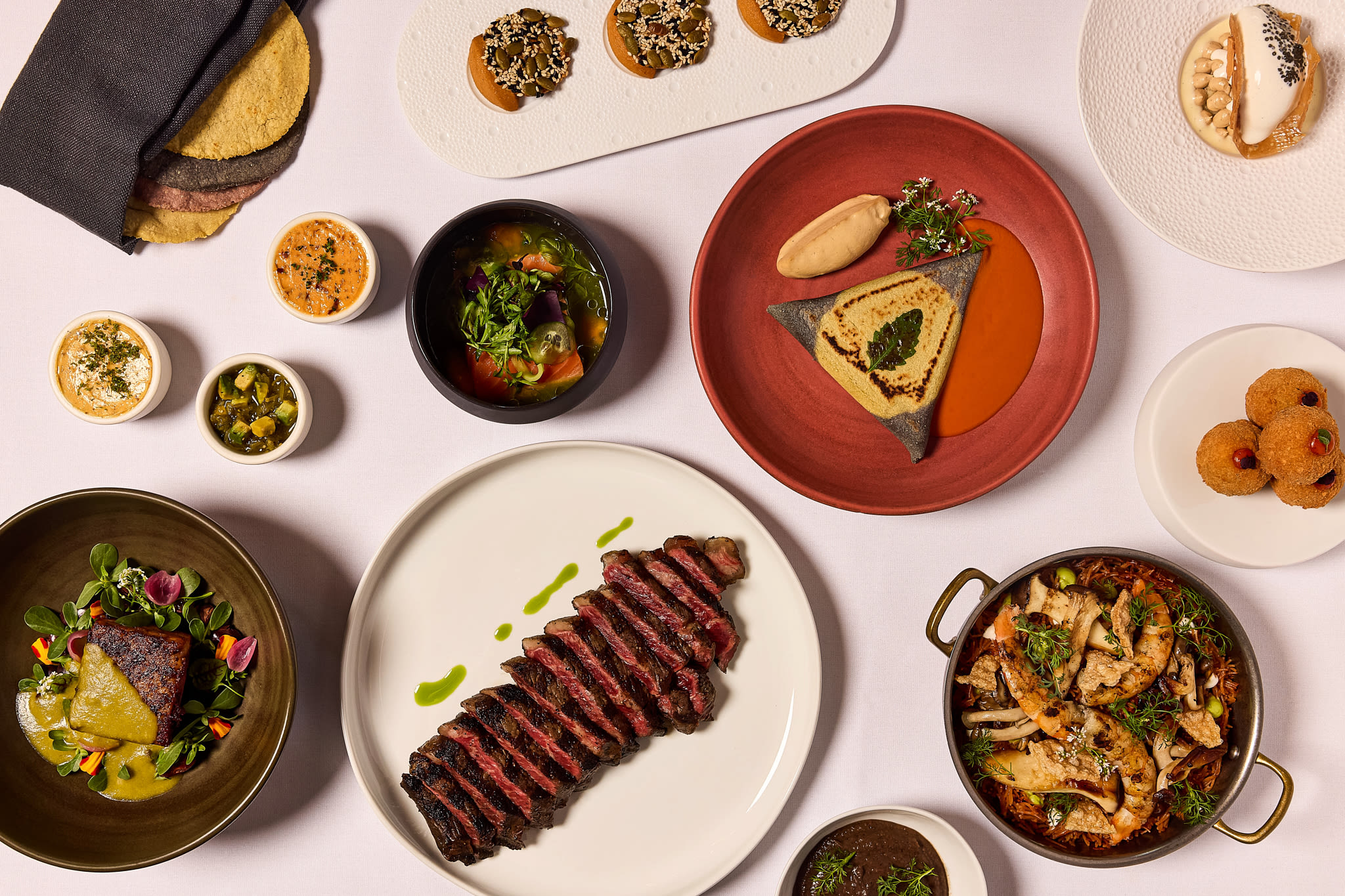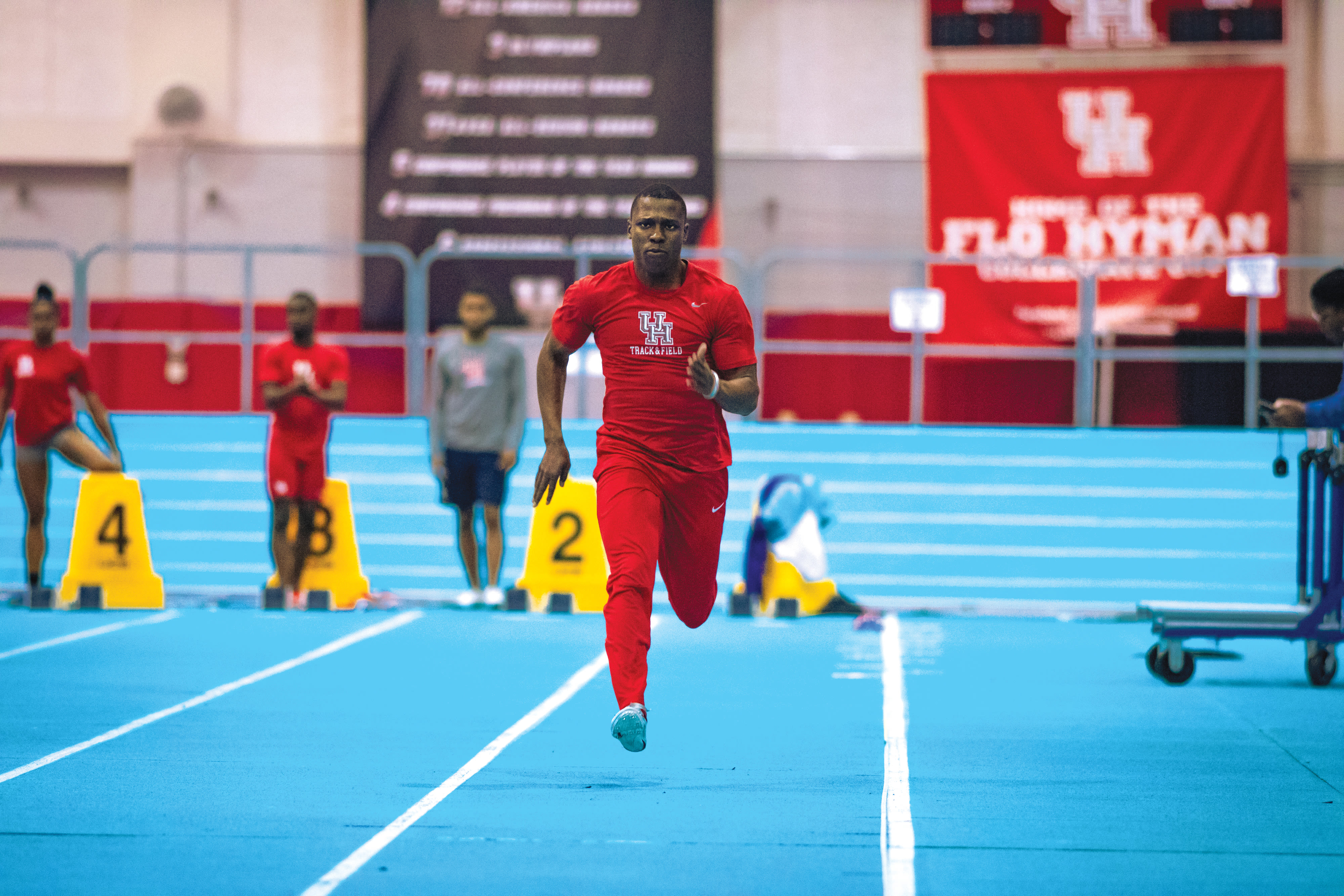
Will the UH Men's Track Team Make History?
Above: Senior John Lewis on UH's new hydraulic indoor track. Photo by Marco Torres.
It was June of last year at the University of Oregon’s historic Hayward Field in Eugene, Oregon, during the Division I NCAA Championships. Crowds packed the stands. The first call for the men’s 4x100-meter relay race rang out, and as eight teams of four runners took the field, each ready to sprint his 100 meters, all eyes, phones, and news cameras were on just one of those teams: the defending champions in the event, the University of Houston. H-Town Speed City, fans call them.
The school’s runners were so fast, they’d won the relay the previous year even without star sprinter Elijah Hall, who’d been injured. Now, though, Hall was a senior, fully healed and ready to go. As always, the 4x100 relay would be the first match of the day. But for UH, this wasn’t going to be just another race. It was going to be a statement.
As junior John Lewis III warmed up in his red sweats and brand-new sneakers, his parents watching from the stands, he thought back to first grade in his rural hometown of Willis, due north of Houston, to the days of his schoolyard Turkey Trots. “Everybody was always like, I got new shoes, I’m gonna beat you.” And now here he was. New shoes. What was he going to do?
Rain came down in sheets as last call sounded. John lined up in his blocks, paying no mind to his drenched uniform. The gun fired. He got out quick and blazed a trail around the curve to Hall, handing off the baton securely, then watched it pass to the third leg, junior Mario Burke, and the fourth, senior Cameron Burrell—“nothing but daylight in front of him,” a commentator noted.
The team clocked 38.17 seconds, not only winning the match but taking down a 29-year-old national collegiate record in the process.
The NCAA Championships—often referred to as Nationals—is a three-day competition with 21 events covering sprinting and running various distances, hurtling, jumping, javelin throwing, and more. Both individual athletes and teams qualify based on their performances at matches held around the country throughout the year, but it’s the teams with the most athletes and the highest scores that take the podium.
UH had eight men competing in Eugene in seven events, with five individual athletes and two relay teams qualifying for the finals, enough to actually put championship-level points on the board for the first time in almost six decades. Junior Kahmari Montgomery not only took seventh in the 400-meter race, he also helped UH take fifth in the 4x400 relay. And Burrell, Hall, and Burke took an astonishing first, second, and eighth in the 100-meter for UH—the only school out of an initial 20 in the prelims with more than one contender in the final.
In the end, the Cougars earned third place overall. It was the first time the men’s team had taken the NCAA podium since 1959, and they’d done it with homegrown talent, to boot. Coach Carl Lewis—yes, that Carl Lewis, no relation to John—proudly points out that “three out of four members of the 2018 NCAA champion relay team are from the greater Houston area: Elijah Hall, Cameron Burrell, and John Lewis.”
Now, the runners, their coaches, and their university are holding out hope that that moment was a taste of great things to come: not just at this year’s NCAA championships, although that too, but the big one. The 2020 Olympics are swiftly approaching. Trials take place in June of next year. Will the Cougars’ track stars make history again, this time on the international stage?
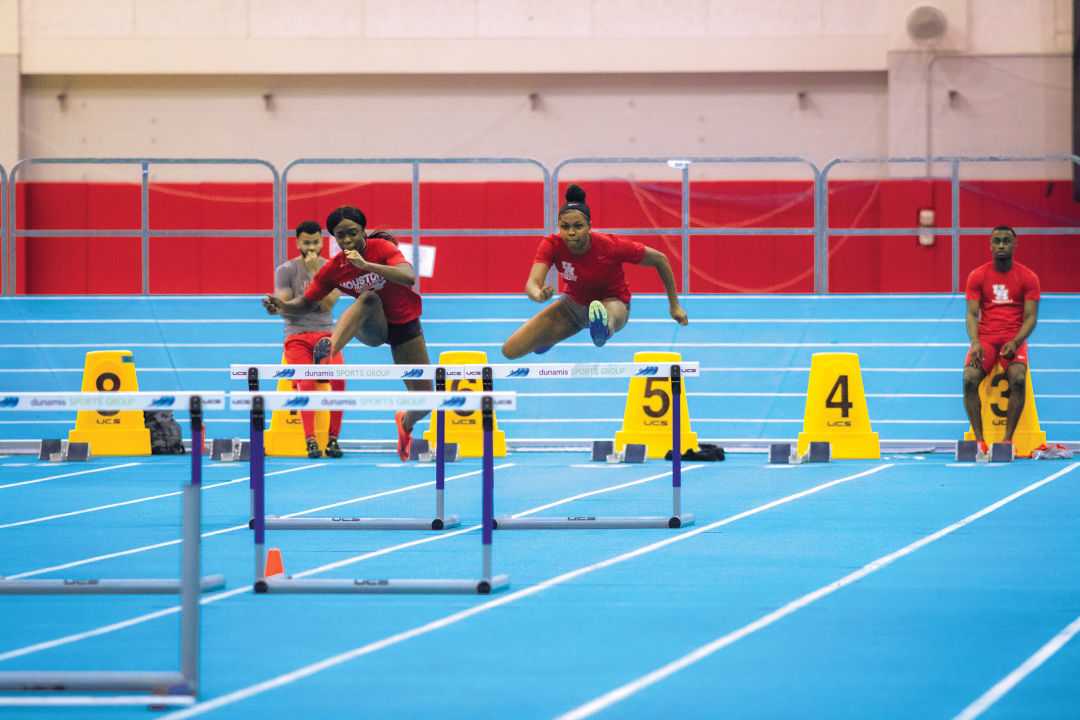
The workouts the UH coaches put their athletes through are grueling.
Image: Marco Torres
In the ancient Olympics, athletes competed in the “stade,” a 192-meter race that stretched across the length of a stadium. Over time the race transformed into today’s 100-meter matches. Competitors reach their peak speed somewhere around 60 meters into the race—Jamaica’s Usain Bolt clocked 27.8 mph at the 2009 World Championships in Berlin, the fastest human speed ever recorded.
The U.S. has been a powerhouse in the 100-meter race for more than a century, since Thomas Burke won gold at the 1896 Olympics. We’ve picked up 16 of the 28 Olympic gold medals ever given for the event. But by 2012 things had changed. America had taken its last 100-meter Olympic gold eight years prior. Carl Lewis—world-famous two-time 100-meter, nine-time overall Olympic gold medalist, and UH alum—found himself dismayed. He sat in the stands at the London Olympics and watched the American men stink it up.
“I called up Roy and said, ‘Can I come down there for one year as a volunteer coach? I had no intention of doing anything more than that.’” Roy, of course, was UH Head Coach Leroy Burrell, a fellow alum, All-American long jumper, and world-record-setting sprinter, who won Olympic gold in the 4x100-meter relay race, in 1992. Burrell had taken over the UH track from his mentor, one of the greatest American track coaches of all time, Tom Tellez, in 1998.
Today Lewis has been with the university for five years. He’s now on the payroll as a full-time sprints coach. And he is, in fact, doing what he set out to do: improving the state of American men’s sprinting. The UH track team has evolved shockingly fast.
Setting Burrell and Lewis apart from other coaches is the fact that they both have accomplished what sprinters on their team hope to do. Each has set collegiate and world records; each has been referred to, at one time, as “the world’s fastest man.” Their experience and knowledge, along with the support of three assistant coaches and a weight trainer, have allowed them to cultivate a new generation of elite athletes while operating on just half the resources found at rival programs like the ones at Florida or LSU, both of which rake in huge dollars to fund athletic programming through football.
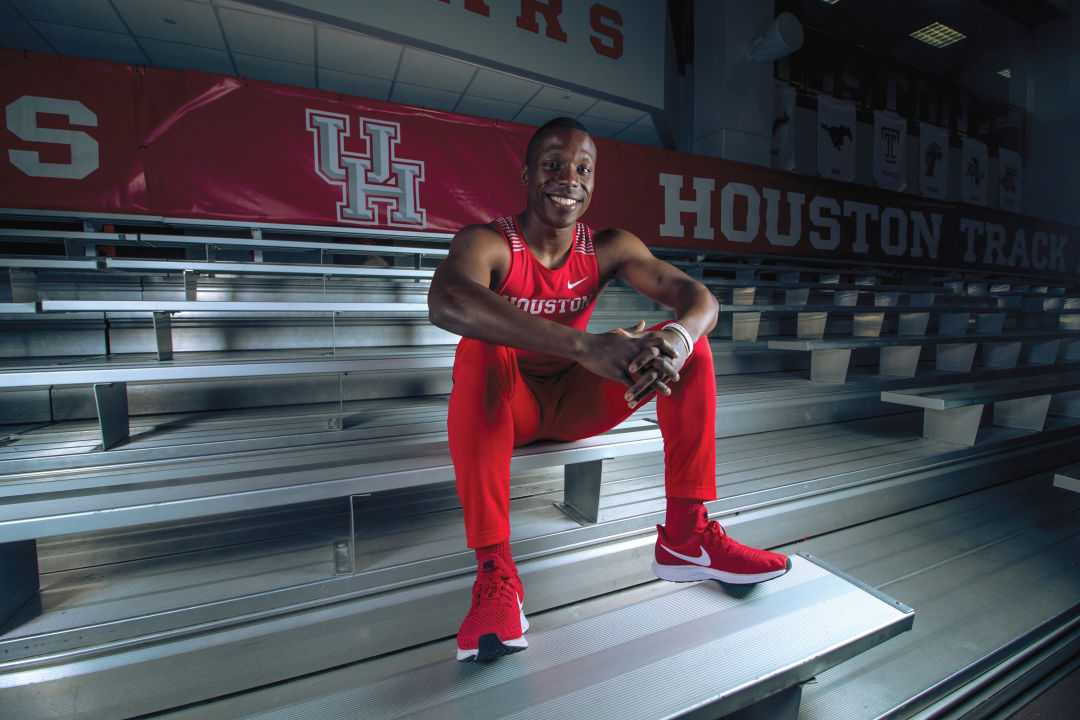
John Lewis is hoping to run with the 4x100 relay team at this year's Nationals.
Image: Marco Torres
Student tuition currently pays for half of Houston’s $60 million athletic budget, of which track operates on roughly $2.2 million per year. “For lack of better terms,” says Burrell, “we don’t really care what others think. We’re doing this with the resources we have.”
Luckily, one of those resources is a brand-new, state-of-the-art, $2 million indoor hydraulic track donated by Net Lease Capital, installed in the university’s Yeoman Fieldhouse, fresh for the 2019 season. Having access to this track, of which there are only 10 in the country—including the one they’ll compete on at this year’s Division I NCAA Indoor Championships in Birmingham, Alabama—should give UH students a leg up.
The program has other advantages, too. Its track coaches still employ the training system developed by retired coach Tom Tellez, who took a scientific approach to coaching, incorporating physiology, kinesiology, and biomechanics into his regime to help his runners get fitter and faster. “He went down to NASA and was like, ‘Excuse me, is this correct?’” says Lewis. It was. Tellez published his research in scientific journals, and his methods are still used today throughout the world.
Lewis has added his own spin to that program. Runners work out in tiered groups based on their 60-meter times—some guys can run 6.5, others 7.0. So, Lewis explains, their objective becomes, Oh my goodness, I want to get into the next group. “It creates competition in practice,” he says. Meanwhile, his work with the sprinters has freed up Burrell to think strategically about the bigger picture and focus on developing 400-meter runners.
There’s also another asset. “We have the best city in the world for high school track and field,” says Lewis. Kids who are serious about running here usually join a youth track club. Lewis, Burrell, and a few fellow Olympians helped start one, CL Stars, in 2001. Joe DeLoach, the 200-meter Olympic gold medalist, serves as coach.
“All we have to do is keep kids here focused on staying home,” says Lewis, “and focusing on their dream.”
More than a dozen CL Star alumni, including John Lewis and Eli Hall, have gone on to run for UH, and now that Coach Burrell and Coach Lewis have added a post-collegiate training program at the school, they’ve created a veritable school-to-Olympics pipeline. The 2020 Olympic trials will be the first litmus test for this approach.
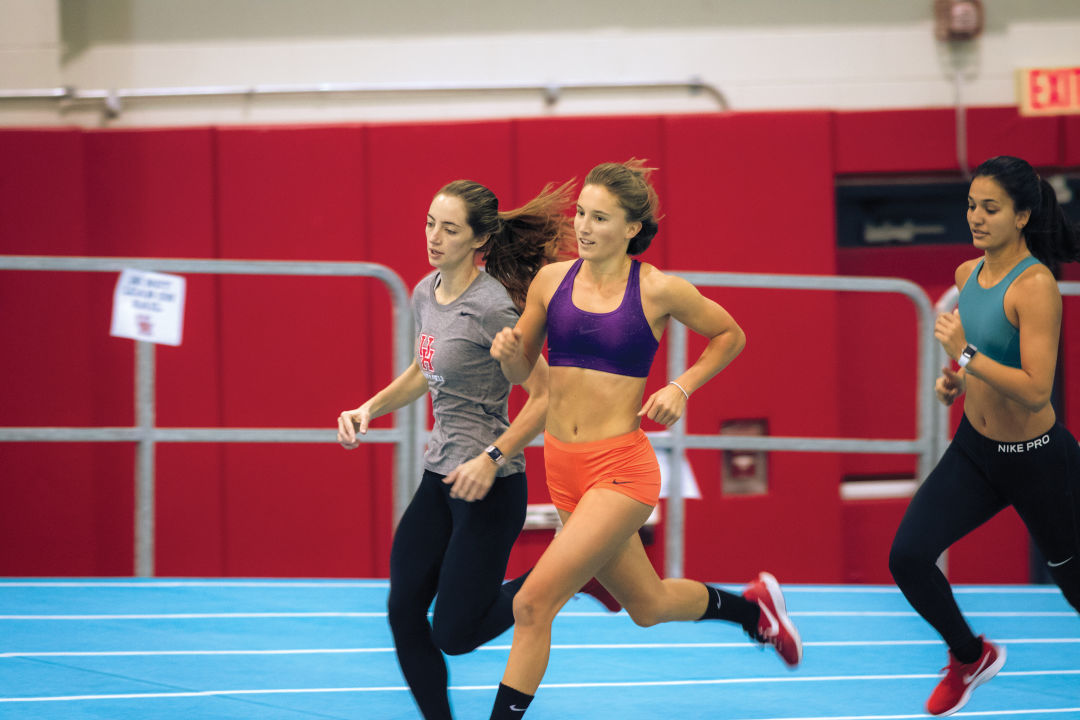
Image: Marco Torres
It was during Coach Lewis’s first year, 2013, that UH welcomed Houston sprinting star Cameron Burrell—also known as Coach Burrell’s extremely fast son. That same year, Coach Lewis promised the school’s president, Renu Khator, that its track team would have no fewer than five Olympians at the 2020 summer games and would win an NCAA championship, too.
“He has this belief in what we can be,” Burrell says. “A damn-the-torpedoes mentality. He brings a competitiveness to the team.”
Tom Lewis (no relation to Carl or John), who calculates the indoor and outdoor national rankings for the nonprofit US Track and Field and Cross-Country Coaches Association, has watched the team’s evolution. “It’s a resurgence,” he says. “They were pretty good back in Carl and Leroy’s day, and it’s fun to see again. Competition in track and field permeates in the Southeastern Conference and Big 12, but not so much outside of that, so UH is breaking that mold.”
Tom Lewis agrees that the Coogs—currently ranked fourth nationally indoors—have a shot at the NCAA Championships. “They were on the podium last year, and whenever you’re that close, you always have a shot to pull off a national title. They did have a few guys graduate, but the mentality and talent are still there.” He believes an overall team win is a longshot, however, because despite the team's good number of superstars, “outdoors has more events than indoors, and UH isn’t strong in throws,” which count more than you’d think.
As for the Olympics, today Coach Lewis trains students as well as “Cam and Eli,” both of whom have graduated and are now sponsored by Nike and Red Bull, along with a few other Coogs-turned-pros making their debuts on the post-collegiate, international circuit. They will all vie with each other for spots on the Olympic team, and, the coach believes, they’ll have competition from the current UH track team, too.
“We’re going to have at least five, probably more like seven to nine runners, at the Olympic trials,” he says.
Tom Lewis thinks the coach’s confidence is warranted. “I definitely could see five to seven of their guys making the trials, and four in the finals. Making the team, now that’s a different story. A lot of things can happen between here and there.”
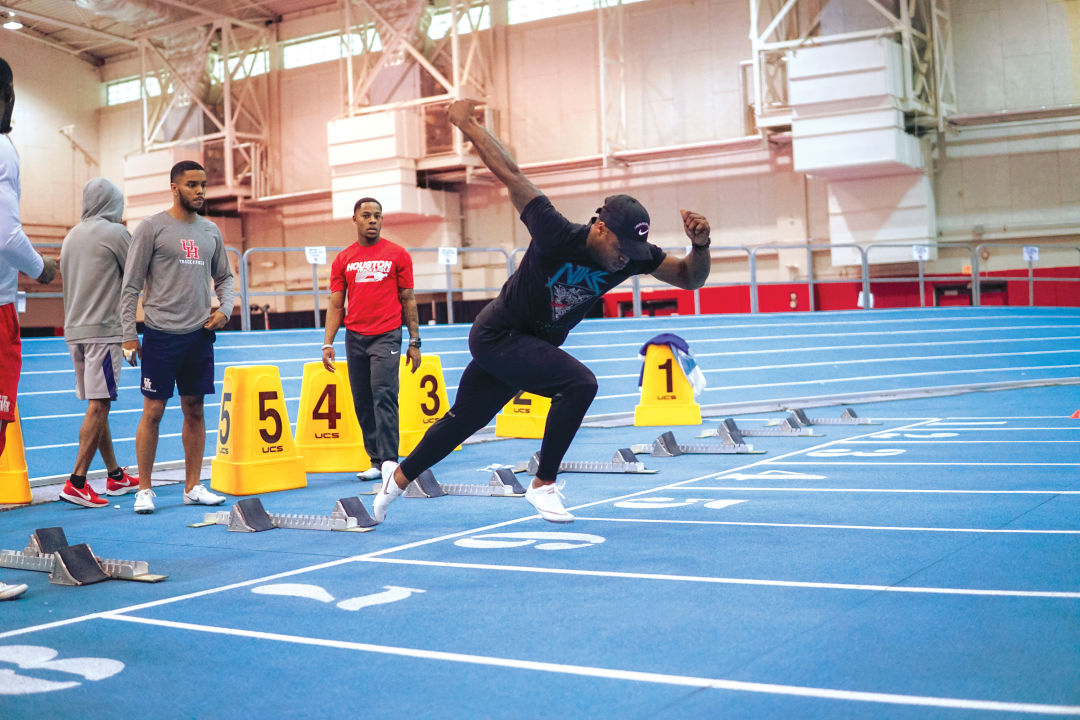
Image: Marco Torres
To become a sprinter at UH, you don’t have to be the best high school runner in the country, but being the best in your class helps. John Lewis III was a Houston-area standout and state qualifier in the 100-meter race for three years at Willis High. Still, his two dream schools, LSU and A&M, weren’t interested. Not fast enough, their coaches informed him.
“UH wasn’t on my radar,” he admits. But then, as a junior, he attended the Houston National Invitational, where he won his race. Afterward his parents urged him to get a picture with Carl Lewis on the field, and he realized, “Why wouldn’t I want to be coached by the world’s greatest?”
Coach Lewis told the high-schooler that if he had a good senior year, UH would be in touch. John won the Texas State Championship in the 100-meter race in 10.34 seconds. The school was in touch. Making the leap from high school to college track and field isn’t easy, though.
You’re not impressing us, Coach Lewis tells all his incoming freshmen. The coaches have been there, done that, and they don’t take kindly to egos or social media braggers. You’ll impress us with your performance, your attitude, your work ethic.
In 2015, as a freshman, John dove into intense, year-round training with men years older and twice his size. UH sprinters mostly weight-train in the morning, and do run workouts midday or in the afternoons—Coach Lewis’s favorite is “Breakdown Monday,” a set of 200-, 300-, and 400-meter races that, even with full rest breaks, can bring a fit runner to his knees. There’s also the delicate balance of class, part-time jobs, volunteer work, studying, and traveling on weekends to compete, sometimes in front of large crowds after long flights.
“Just being comfortable on the collegiate stage,” says John, who runs the 60-meter indoor, plus the 100- and 200-meter outdoor races, “can be a hurdle to overcome. As a freshman I was like, Man, these guys are so fast, where do I stand? Can I compete?”
In 2016 John watched his freshman roommate, Jacarias Martin of Katy, along with then-freshman Burke, compete in the 4x100-meter relay at Nationals, while he went as the alternate. But the following year, as a sophomore, John found himself on the team after Hall injured himself and had to sit out. It was the Coogs’ first 4x100-meter Nationals win, and they set a school record. In 2018 he again earned a spot on the relay team, and they set their national record.
“As for the schools that didn’t want me,” he says today, “it was like, look where I’m at now.”
Still, there are no certainties about who will be put on the relay team heading to Nationals this year—it all boils down to hard work, preparation, and—sometimes—odd circumstances. There are about 14 competitive sprinters on the team vying for four spots, and Lewis mixes and matches them in races throughout the year to keep them on their toes. “The team that ran at Nationals only ran at Nationals,” he says, looking back at last year’s season. “They’d never run together before. They go there—first round, clockwork. Second round, collegiate record. That’s the kind of guys we got.”
Not everyone agrees with him. With Cameron Burrell and Elijah Hall now on to the pros, some say the Cougars may not be contenders for the title this year. Foolish, says Coach Burrell. “We’re deeper than people give us credit for.”
Senior Mario Burke, for starters, is currently ranked second among collegiate 100-meter sprinters and already has run this year’s sixth-fastest time in the indoor 60-meter race—in the entire world. John Lewis and Jacarias Martin are right behind him in practice, as is up-and-coming sophomore Nicholas Alexander.
Filling out the team is a cadre of dazzling seniors: Amere Lattin, who false-started at Nationals last year and will look for redemption in the hurdling events; world-class long jumper Jared Kerr; and 400-meter runner Kahmari Montgomery, who won the USATF Outdoor Championships in July. Burke, Obi Igbokwe, and Trumaine Jefferson are already favorites for the 4x400-meter title.
“We’re two-time defending champions in the 4x100. We’re the number one in the world in the 4x400 right now,” asserts Coach Lewis. “This is the year to win the championship.”
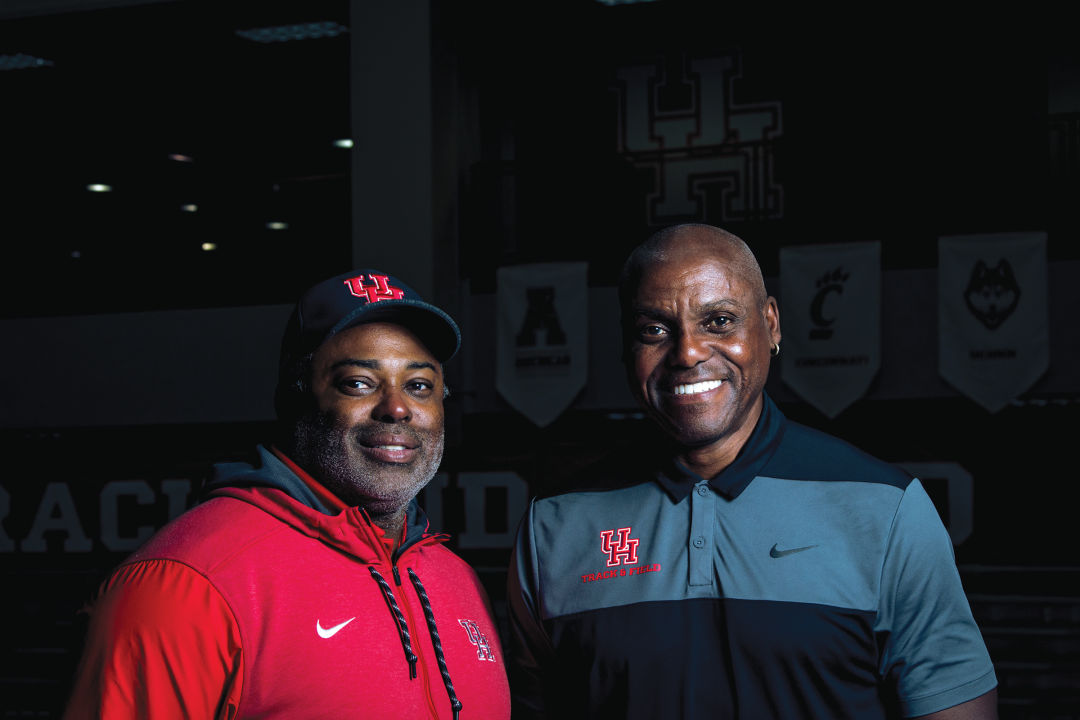
World's fastest coaches? Leroy Burrell and Carl Lewis
Image: Marco Torres
On a winter day inside the sprawling UH Athletics/Alumni Center, five of the fastest men in the world stand in the middle of their new baby-blue indoor track. Handmade by an Olympic pole-vaulter-turned-engineer in Estonia, its short curves bank away from the ground like a rubber velodrome.
Newly minted pros Elijah Hall, Cameron Burrell, and LeShon Collins are finishing up a workout—shirtless, sweat drenching their ice-cube abs—as coaches Lewis and Burrell adjust cones nearby. It’s just a typical Technical Tuesday, as Lewis calls it, a day when jumpers jump and sprinters take starts, whether they’re pros or students. There’s a big audience in the stands of the Yeoman Fieldhouse. The 100 men and women on the track team are waiting for their weekly meeting to begin.
Clad mostly in red, white, and black Cougar sweats, the students look like typical 19-year-olds, lazing around, joking, playing on their phones. But as soon as the three athletes take their last start, sprinting down the 60-meter straightaway like gods, there is a hush. Every eye in the house is watching these men—their chins down, their feet a blur, their arm strokes seamless—at a blistering four beats per second.
The pros reach the end of the line, hitting the wall-mounted padding, before returning to Coach Lewis for a powwow and gathering their things while Coach Burrell starts his meeting, a buzz in the air.
Afterward they stop to talk to their former teammates. The scene isn’t so different from last year, except now they don’t have schoolwork, and their new Nike backpacks are stuffed with Nike gear. John Lewis’s backpack, meanwhile, is filled with creative writing and English books. He stops to say hi to the pros and a few guys that Hall calls his “young ones,” of whom John says, “you don’t know yet, but will.” In their heads, yes, they’re all thinking about the Olympic trials—what will they sacrifice to get there? But first it’s the NCAA Championships and, honestly, just getting through practice today.
“Hey, guys,” Coach Lewis interrupts the group, selecting two unsuspecting freshmen, as the pros hurry off toward the locker rooms. “Go pick up those little cones and put the bigger ones down, will you? Then we can get started.”



